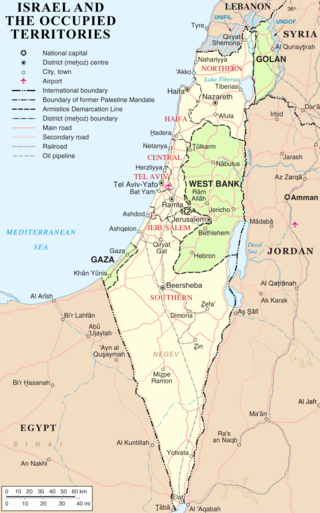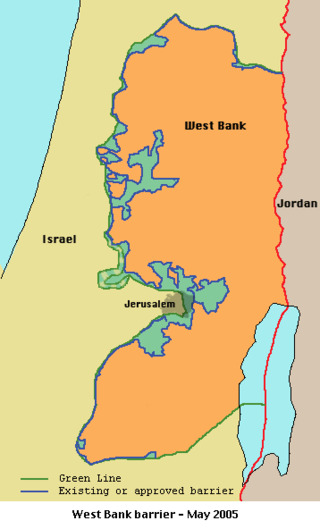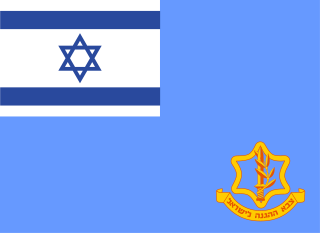
The Gaza Strip, or simply Gaza, is a polity and the smaller of the two Palestinian territories. On the eastern coast of the Mediterranean Sea, Gaza is bordered by Egypt on the southwest and Israel on the east and north.

Israeli settlements or colonies are civilian communities where Israeli citizens live, almost exclusively of Jewish identity or ethnicity, built on lands occupied by Israel since the Six-Day War in 1967. The international community considers Israeli settlements to be illegal under international law, though Israel disputes this.

The West Bank, so called due to its relation to the Jordan River, is the larger of the two Palestinian territories. A landlocked territory near the coast of the Mediterranean Sea in the Levant region of Western Asia, it is bordered by Jordan and the Dead Sea to the east and by Israel to the south, west, and north. The territory has been under Israeli occupation since 1967.

The Palestinian territories are the two regions of the former British Mandate for Palestine that have been occupied by Israel since the Six-Day War of 1967, namely the West Bank and the Gaza Strip. The International Court of Justice (ICJ) has referred to the West Bank, including East Jerusalem, as "the Occupied Palestinian Territory", and this term was used as the legal definition by the ICJ in its advisory opinion of July 2004. The term occupied Palestinian territory was used by the United Nations and other international organizations between October 1999 and December 2012 to refer to areas controlled by the Palestinian National Authority, but from 2012, when Palestine was admitted as one of its non-member observer states, the United Nations started using exclusively the name State of Palestine. The European Union (EU) also uses the term "occupied Palestinian territory". The government of Israel and its supporters use the label "disputed territories" instead.

Palestine, officially the State of Palestine, is a state in the Southern Levant region of West Asia. Founded on 15 November 1988 and officially governed by the Palestine Liberation Organization (PLO), it claims the West Bank and the Gaza Strip as its territory, all of which has been Israeli-occupied territories since the 1967 Six-Day War. The West Bank contains 165 Palestinian enclaves that are under partial Palestinian rule, but the remainder, including 200 Israeli settlements, is under full Israeli control. The Gaza Strip was governed by Egypt but conquered by Israel in 1967. Israel governed the region until it withdrew in 2005. Hamas seized power after winning the 2006 Palestinian legislative election. The Gaza Strip has since been blockaded by Israel and Egypt.

Aqabah is a Palestinian village in the northeastern West Bank, which is being targeted for demolition by the Israeli Civil Administration as the majority of structures were alleged to have been built without permits from the Israeli military administration. Surrounded by two Israeli military bases and a ‘virtual wall’ of checkpoints, Al-Aqaba's connections to neighboring communities, markets and the Jordan Valley have been gradually severed: since 1967, al-Aqaba's population has decreased by 85%, dropping from around 2,000 to less than 200 today. While many al-Aqaba residents no longer live in the village itself, they still hope to return to their land, and still send their children to the local school.

Beit El or Beth El is an Israeli settlement and local council located in the Binyamin Region of the West Bank. The Orthodox Jewish town was settled in 1977–78 by the ultranationalist group Gush Emunim. It is located in the hills north of Jerusalem, east of the Palestinian city of al-Bireh, adjacent to Ramallah. In September 1997, Beit El was awarded local council status. The head of the local council is Shai Alon. In 2021 its population was 5,681.

Israel has occupied the Palestinian territories and the Golan Heights since the Six-Day War of 1967. It used to occupy the Sinai Peninsula and southern Lebanon as well. Prior to Israel's victory in the Six-Day War, occupation of the Palestinian territories was split between Egypt and Jordan, with the former having occupied the Gaza Strip and the latter having annexed the West Bank; the Sinai Peninsula and the Golan Heights were under the sovereignty of Egypt and Syria, respectively. The first conjoined usage of the terms "occupied" and "territories" with regard to Israel was in United Nations Security Council Resolution 242, which was drafted in the aftermath of the Six-Day War and called for: "the establishment of a just and lasting peace in the Middle East" to be achieved by "the application of both the following principles: ... Withdrawal of Israeli armed forces from territories occupied in the recent conflict ... Termination of all claims or states of belligerency and respect for and acknowledgment of the sovereignty, territorial integrity and political independence of every State in the area and their right to live in peace within secure and recognized boundaries free from threats or acts of force."
The status of territories captured by Israel is the status of the Gaza Strip, the West Bank, the Golan Heights, and the Sinai Peninsula, all of which were captured by Israel during the 1967 Six-Day War.

Dheisheh is a Palestinian refugee camp located just south of Bethlehem in the West Bank. Dheisheh was established in 1949 on 0.31 square kilometers of land leased from the Jordanian government. The camp was established as a temporary refuge for 3,400 Palestinians from 45 villages west of Jerusalem and Hebron who fled during the 1948 Arab–Israeli War. The camp had a population of 8,805 in 2017.

Seam Zone is a term used to refer to a land area in the Israeli-occupied West Bank located east of the Green Line and west of Israel's separation barrier, populated largely by Israelis in settlements such as Alfei Menashe, Ariel, Beit Arye, Modi'in Illit, Giv'at Ze'ev, Ma'ale Adumim, Beitar Illit and Efrat.

Demolition of Palestinian property is a method Israel has used in the Israeli-occupied territories since they came under its control in the Six-Day War to achieve various aims. Broadly speaking, demolitions can be classified as either administrative, punitive/dissuasive and as part of military operations. The Israeli Committee Against House Demolitions estimated that Israel had razed 55,048 Palestinian structures as of 2022. Administrative house demolitions are done to enforce building codes and regulations, which in the occupied Palestinian territories are set by the Israeli military. Critics claim that they are used as a means to Judaize parts of the occupied territory, especially East Jerusalem. Punitive house demolitions involve demolishing houses of Palestinians or neighbors and relatives of Palestinians suspected of violent acts against Israelis. These target the homes where the suspects live. Proponents of the method claim that it deters violence while critics claim that it has not been proven effective and might even trigger more violence. Punitive house demolitions have been criticized by a Palestinian human rights organization as a form of collective punishment and thus a war crime under international law.
Palestinian land laws dictate how Palestinians are to handle their ownership of land under the Palestinian National Authority—currently only in the West Bank. Most notably, these laws prohibit Palestinians from selling any Palestinian-owned lands to "any man or judicial body corporation of Israeli citizenship, living in Israel or acting on its behalf". These land laws were originally enacted during the Jordanian occupation of the West Bank, which began after Jordan's partial victory during the 1948 Arab–Israeli War and ended after the sweeping defeat of the Arab coalition to the Israeli military during the 1967 Arab–Israeli War, following which the territory was occupied by Israel. Land sales by Palestinians to Israelis are considered treasonous by the former to the Palestinian national cause because they threaten the aspiration for an independent Palestinian state. The prohibition on land-selling to Israelis in these laws is also stated as enforced in order to "halt the spread of moral, political and security corruption". Consequently, Palestinians who sell land to Israelis can be sentenced to death under Palestinian governance, although death penalties are seldom carried out; capital punishment has to be approved by the President of the Palestinian National Authority.
Military order 1650 is an Israeli military order issued on 13 October 2009. It is an amendment to Military Order No. 329, "Order Regarding Prevention of Infiltration", and significantly expands the definition of 'infiltrator' such that any person in the West Bank could fall under the scope of the definition, and be subject to arrest or deportation by the Israeli Defense Forces (IDF) without judicial review. The order was signed by Gadi Shamni, Major General and commander of IDF Forces in the Judea and Samaria Area.

The Israeli Military Governorate was a military governance system established following the Six-Day War in June 1967, in order to govern the civilian population of the West Bank, the Gaza Strip, the Sinai Peninsula and the western part of Golan Heights. The governance was based on the Fourth Geneva Convention, which provides guidelines for military rule in occupied areas. East Jerusalem was the only exception from this order, and it was added to Jerusalem municipal area as early as 1967, and extending Israeli law to the area effectively annexing it in 1980. During this period, the UN and many sources referred to the military governed areas as Occupied Arab Territories.

Israel–Palestine relations refers to the political, security, economical and other relations between the State of Israel and the State of Palestine. Israel and the PLO began to engage in the late 1980s and early 1990s in what became the Israeli–Palestinian peace process, culminated with the Oslo Accords in 1993. Shortly after, the Palestinian National Authority was established and during the next 6 years formed a network of economic and security connections with Israel, being referred to as a fully autonomous region with self-administration. In the year 2000, the relations severely deteriorated with the eruption of the Al-Aqsa Intifada – a rapid escalation of the Israeli–Palestinian conflict. The events calmed down in 2005, with reconciliation and cease fire. The situation became more complicated with the split of the Palestinian Authority in 2007, the violent split of Fatah and Hamas factions, and Hamas' takeover of the Gaza Strip. The Hamas takeover resulted in a complete rift between Israel and the Palestinian faction in the Gaza Strip, cancelling all relations except limited humanitarian supply.

Area C is the fully Israeli-controlled and only contiguous territory in the West Bank, defined as the whole area outside the Palestinian enclaves. Area C constitutes about 61 percent of the West Bank territory, contains all Israeli settlements other than those in East Jerusalem, and more than 99% of the area is off limits or heavily restricted for Palestinians. The area was committed in 1995 under the Oslo II Accord to be "gradually transferred to Palestinian jurisdiction", but such transfer did not happen. The area is richly endowed with natural resources.

The West Bank, including East Jerusalem, has been under military occupation by Israel since 7 June 1967, when Israeli forces captured the territory, then ruled by Jordan, during the Six-Day War. The status of the West Bank as a militarily occupied territory has been affirmed by the International Court of Justice and, with the exception of East Jerusalem, by the Israeli Supreme Court. The official view of the Israeli government is that the laws of belligerent occupation do not apply to the territories, which it considers instead "disputed", and it administers the West Bank, excepting East Jerusalem, under the Israeli Civil Administration, a branch of the Israeli Ministry of Defense. Considered to be a classic example of an "intractable" conflict, the length of Israel's occupation was already regarded as exceptional after two decades, and is now the longest in modern history. Israel has cited several reasons for retaining the West Bank within its ambit: a claim based on the notion of historic rights to this as a homeland as claimed in the Balfour Declaration of 1917; security grounds, both internal and external; and the deep symbolic value for Jews of the area occupied.

The Israeli permit regime in the West Bank is the legal regime that requires Palestinians to obtain a number of separate permits from the Israeli military authorities governing Palestinians in the Israeli-occupied West Bank for a wide range of activities. The first military order requiring permits for the Palestinians was issued before the end of the 1967 Six-Day War. The two uprisings of 1987 and 2001 were met by increased security measures, differentiation of IDs into green and red, policies of village closures, curfews and more stringent restrictions on Palestinian movement, with the general exit permit of 1972 replaced by individual permits. The stated Israeli justification for this new permit regime regarding movements was to contain the expansion of the uprisings and protect both the IDF and Israeli civilians from military confrontations with armed Palestinians. The regime has since expanded to 101 different types of permits covering nearly every aspect of Palestinian life, governing movement in Israel and in Israeli settlements, transit between Gaza and the West Bank, movement in Jerusalem and the seam zone, and travel abroad via international borders. The Israeli High Court has rejected petitions against the permit regime, allowing that it severely impinges on the rights of Palestinian residents but that the harm was proportionate.
Land expropriation in the West Bank refers to the practices employed by the State of Israel to take over Palestinian land in the occupied West Bank. From 1969 to 2019 Israel had issued over 1,150 military seizure orders alone to that purpose.













